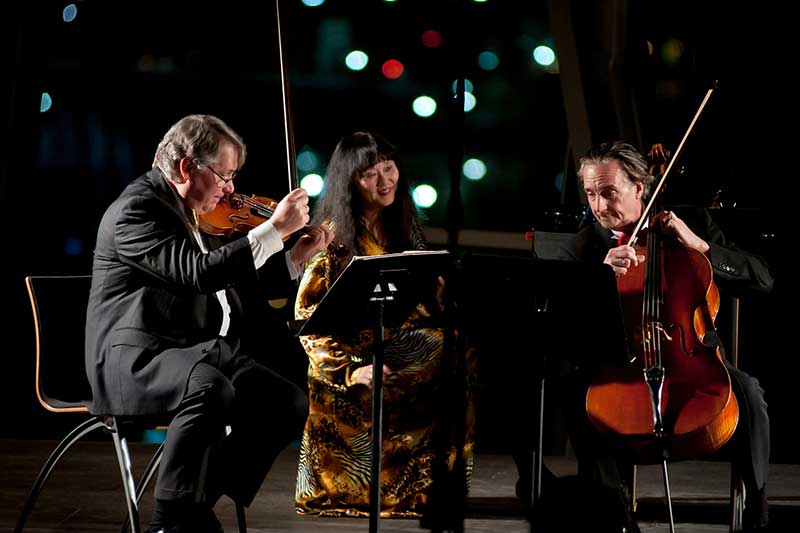Chamber Music Society all-stars soar in introspective piano quartet program

Philip Setzer, Wu Han, and David Finckel performed Friday night in the Barns at Wolf Trap.
It is regrettable that the piano quartet did not become as popular with composers as the string quartet or piano trio. Few ensembles devoted exclusively to the piano quartet exist, meaning that performances usually come from larger groups like Chamber Music Society of Lincoln Center. One such opportunity came from four veterans of that ensemble, heard Friday night in the sold-out Barns at Wolf Trap.
Violinist Philip Setzer and violist Paul Neubauer joined Chamber Music Society’s artistic directors, pianist Wu Han and cellist David Finckel, for two piano quartets that bookended this pleasing program. In a surprise move, they performed Mozart’s Piano Quartet No. 2, the less often heard of the composer’s two examples of the genre, to open the concert.
The cohesive, expertly balanced sound of the ensemble brought out many subtle effects in the score. Mozart, himself an occasional violist, gave that instrument some crucial solos, played with admirable warmth by Neubauer, particularly in the first movement. Wu Han’s keyboard part in the first two movements came across with sparkling lightness, allowing both Setzer and Finckel to play with a slender softness.
The central slow movement proved the highlight, with a delicate ensemble tone that invited the listener to lean in with attention. After a mid-movement cadenza in the piano, played musingly by Wu Han, Setzer added tender echoes to the main theme. In the third movement, Wu Han took control with her more expansive fingerwork, as the group drew out the humorous twists and turns of the piece, even at a rather fast tempo.
Bedřich Smetana never composed a piano quartet, but the ensemble, without Neubauer, offered instead a devastating rendition of the Czech composer’s Piano Trio No. 1. Smetana dedicated the score to Bedřiška, his eldest daughter, who died of scarlet fever in 1855. Although she was only four, the girl had already shown exceptional musical talent, which gave her a special connection to her father, for whom she was named.
Setzer produced some of his richest sound on the folk-like introduction to the first movement, a solo line set deep on the violin’s G string. Wu Han took over with broad-handed chromatic sweep in the A theme at the keyboard, followed by Finckel’s slightly understated rendition of the heart-melting B theme. When the development spun up to its Più Animato tempo, Setzer’s intonation in the higher, louder sections buckled somewhat under the pressure.
The pianist added Chopinesque rubato and whimsy to the cadenza that led to the recapitulation. When Setzer reprised the opening solo line, a prominent off note came as an unpleasant surprise, but the violinist recovered without further trouble. Smetana transformed that main theme into a polka-like theme in the central Intermezzo, a heavy-footed dance contrasted with two Alternativo sections. The ensemble had their strongest moments in the enigmatic Andante, while lacking heft in the strings for the Maestoso.
Lunging into the Finale, the trio dashed through Smetana’s reworking of an earlier piano sonata, playing so fast that the duple-versus-triple polyrhythms barely registered on the ear. Setzer and Finckel excelled in the slower music of the B section, pining on those arching, tranquil lines. Smetana, who had already lost a child to tuberculosis, would also lose another child and his first wife in a matter of years.
Antonín Dvořák also wrote two piano quartets, and the evening concluded with the later, more mature Piano Quartet No. 2. Although ostensibly in the key of E-flat major, the piece immediately flirts with the darker minor mode in the hammered string unison of the opening theme. The second theme moves to an even more distant key, with Dvořák, who was also a violist like Mozart, giving a central role to that instrument, which Neubauer answered with consummate richness of tone.
Finckel’s most musical playing came in the ardent solo of the slow movement, the quartet’s longest, answered by the transparent softness of Wu Han’s keyboard. Setzer matched Finckel with a suave interpretation of the tune, accompanied by murmuring piano and viola, although the stormy middle section elicited some less refined sounds. The gentle Ländler of the third movement had just the right homespun character, especially in the second theme, with its exotic augmented seconds in the piano, evoking the folk-music strangeness of a cimbalom.
The Finale featured more solid playing from Neubauer, with the viola given an often starring role again by Dvořák. Wu Han impressed with page after page of daunting octaves. After opening once more in the somewhat haunting key of E-flat minor, the piece wandered through multiple harmonic areas before settling on E-flat major for a triumphant finish. In spite of exciting playing from all four musicians, leading to a rousing ovation, there was no encore.
Pianist Juho Pohjonen anchors a program of unusual chamber music selections, culminating in the Hummel Septet, 3 p.m. March 10. wolftrap.org




